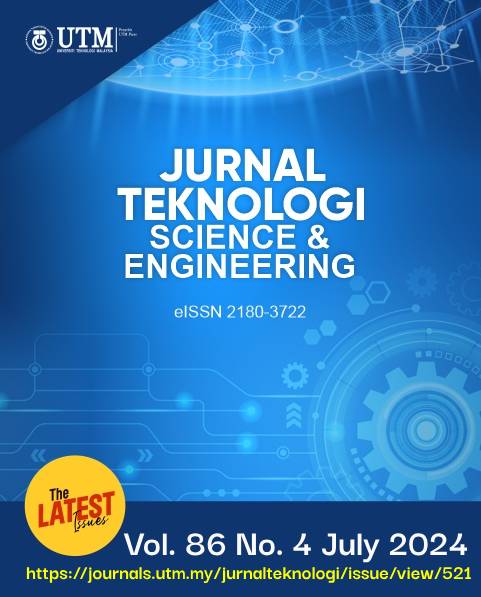COMPARATIVE OF RIVEST-SHAMIR-ADLEMAN CRYPTOSYSTEM AND ITS FOUR VARIANTS USING RUNNING TIME AND MEMORY CONSUMPTION ANALYSIS
DOI:
https://doi.org/10.11113/jurnalteknologi.v86.20723Keywords:
Cryptosystem, single precision, encryption, running time, memory consumptionAbstract
The Rivest-Shamir-Adleman (RSA) algorithm, known for its slow single-precision multiplication (spm) and overall running time, is not commonly employed to encrypt user data directly. As a result, several researchers have developed various RSA-based cryptosystems to enhance the algorithm's performance while maintaining security. This paper presents a comparative analysis of different variants of the RSA cryptosystem, focusing on five specific cryptosystems: RSA, Somsuk-RSA, Modified-RSA (MRSA), Easy Simple Factoring-RSA (ESF-RSA), and Phony-RSA. The methodology involves evaluating the theoretical running time and memory usage through single-precision multiplication (spm) measurements, while the actual running time is estimated using Maple programming. The research has two primary objectives. Firstly, they examined each algorithm of the RSA variants and analysed them according to the proposed methodology. Secondly, to determine which cryptosystem consumes the most time and memory for key generation, encryption, and decryption. The results indicate that ESF-RSA and RSA are the fastest in terms of key generation, ESF-RSA is the quickest for encryption, and Phony-RSA excels in decryption speed. Additionally, ESF-RSA demonstrates the lowest memory usage, whereas MRSA requires the highest memory allocation for all processes.
References
Canetti, R., Halevi, S. and Katz, J. 2004. Chosen-ciphertext Security from Identity-based Encryption. Advances in Cryptology-EUROCRYPT 2004: International Conference on the Theory and Applications of Cryptographic Techniques, Interlaken, Switzerland, May 2-6, 2004. Springer Berlin Heidelberg. 23: 207-222.
Doi: https://doi.org/10.1007/978-3-540-24676-3_13.
Barakat, M., Eder, C. and Hanke, T., 2018. An Introduction to Cryptography. Timo Hanke at RWTH Aachen University. 1-145. Retrieved: 1 July 2023.
Alqad, Z., Oraiqat, M., Almujafet, H., Al-Saleh, S., Al Husban, H. and Al-Rimawi, S. 2019. A New Approach for Data Cryptography. International Journal of Computer Science and Mobile Computing. 8(9): 30-48.
Saloma, A. 2006. Public-key Cryptography. 2nd edition. Springer Science & Business Media.
Pal, S. K. and Mishra, S. 2019. An TPM based Approach for Generation of Secret Key. International Journal of Computer Network and Information Security. 11(10): 45-50.
Doi: https://doi.org/10.5815/ijcnis.2019.10.06.
Menezes, A. J., Van Oorschot, P. C. and Vanstone, S. A. 2018. Handbook of Applied Cryptography. CRC Press.
Doi: https://doi.org/10.1201/9781439821916.
Asbullah, M. A. and Ariffin, M. R. K. 2014. Comparative Analysis of Three Asymmetric Encryption Schemes based Upon the Intractability of Square Roots Modulo N= p^ 2 q. 4th International Cryptology and Information Security Conference. 24-26.
Diffie, W. and Hellman, M. E. 2022. New Directions in Cryptography. Democratizing Cryptography: The Work of Whitfield Diffie and Martin Hellman. 365-390.
Doi: https://doi.org/10.1145/3549993.3550007.
Hue, S. Y., Sarmin, N. H., Ismail, E. S. and Chin, J. J. 2020. December. Easy Simple Factoring-based Digital Signature Scheme. 2020 15th International Conference for Internet Technology and Secured Transactions (ICITST). 1-4). IEEE.
Doi: https://doi.org/10.23919/ICITST51030.2020.9351341.
Rivest, R.L., Shamir, A. and Adleman, L. 1978. A Method for Obtaining Digital Signatures and Public-key Cryptosystems. Communications of the ACM. 21(2): 120-126.
Doi: https://doi.org/10.1145/359340.359342.
Al Hasib, A. and Haque, A. A. M. M. 2008. A Comparative Study of the Performance and Security Issues of AES and RSA Cryptography. 2008 Third International Conference on Convergence and Hybrid Information Technology. IEEE. 2: 505-510.
Doi: https://doi.org/10.1109/ICCIT.2008.179.
Somsuk, K. 2017, November. The New Equation for RSA's Decryption Process Appropriate with High Private Key Exponent. 2017 21st International Computer Science and Engineering Conference (ICSEC). IEEE. 1-5.
Doi: https://doi.org/10.1109/ICSEC.2017.8443858.
Somsuk, K. 2021. A New Methodology to Find Private Key of RSA Based on Euler Totient Function. Baghdad Science Journal. 18(2): 338-348.
Doi: https://doi.org/10.21123/bsj.2021.18.2.0338.
Islam, M. A., Islam, M. A., Islam, N. and Shabnam, B. 2018. A Modified and Secured RSA Public Key Cryptosystem based on “n” Prime Numbers. Journal of Computer and Communications. 6(03): 78.
Doi: https://doi.org/10.4236/jcc.2018.63006.
Imam, R., Anwer, F. and Nadeem, M. 2022. An Effective and Enhanced RSA based Public Key Encryption Scheme (XRSA). International Journal of Information Technology. 14(5): 2645-2656. Doi: https://doi.org/10.1007/s41870-022-00993-y
Ismail, E. S., Zaharidan, M. Z. and Samat, F. A. I. E. Z. A. 2018. ESF: Suatu Kriptosistem Mudah Ringkas Berasaskan Masalah Pemfaktoran. Journal of Quality Measurement and Analysis JQMA. 14(2): 81-89.
Raghunandan, K. R., Aithal, G. and Shetty, S. 2019. Secure RSA Variant System to Avoid Factorization Attack using Phony Modules and Phony Public Key Exponent. Int J Innov Technol Exploring Eng (IJITEE). 8(9).
Doi: https://doi.org/10.35940/ijitee.I7807.078919.
Puneeth, B. R., Raghunandan, K. R., Bhavya, K., Shetty, S., NS, K. R., Dodmane, R. and Islam, S. M. 2022. Preserving Confidentiality against Factorization Attacks using Fake Modulus ($zeta $) Approach in RSA and its Security Analysis. 2022 IEEE 9th Uttar Pradesh Section International Conference on Electrical, Electronics and Computer Engineering (UPCON) IEEE. 1-6.
Asbullah, M. A., Ariffin, M. R. K. and Mahad, Z. 2016. Analysis on the Rabin-p Cryptosystem. AIP Conference Proceedings AIP Publishing. 1787(1).
Doi: https://doi.org/10.1063/1.4968151.
Vuillaume, C. 2003. Efficiency Comparison of Several RSA Variants Master Thesis. Fachbereich Informatik der TUDarmstadt.
Downloads
Published
Issue
Section
License
Copyright of articles that appear in Jurnal Teknologi belongs exclusively to Penerbit Universiti Teknologi Malaysia (Penerbit UTM Press). This copyright covers the rights to reproduce the article, including reprints, electronic reproductions, or any other reproductions of similar nature.
















